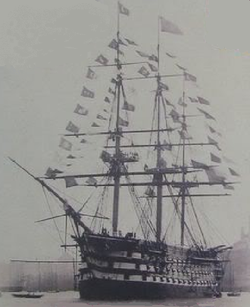- Ottoman ship Mahmudiye
-
This article is about the Ottoman Navy ship-of-the-line Mahmudiye. For the town in Turkey, see Mahmudiye.

Ottoman Navy ship-of-the-line Mahmudiye (1829) in ConstantinopleCareer (Ottoman Empire) 
Name: Mahmudiye Owner: Ottoman Navy Builder: Tersane-i Amire (Imperial Shipyard), Constantinople Launched: 1829 Decommissioned: 1874 Honours and
awards:Title of Gazi awarded to the ship for her role during the Siege of Sevastopol (1854–1855) Fate: Broken up General characteristics Length: 76.15 m (249.8 ft) Beam: 21.22 m (69.6 ft) Armament: 128 guns on three decks The Mahmudiye (Turkish: Mahmudiye kalyonu), built in 1829, was a ship of the line of the Ottoman Navy. She was a three–masted three–decked 128–gunned sailing ship, which could perhaps be considered to be one of the few completed heavy-first rate battleships.[1] The Mahmudiye, with a roaring lion as the ship's figurehead, served to reconstitute the morale of the nation after the loss of the fleet at the Battle of Navarino in 1827. The flagship was for many years the largest warship in the world.[1]
She was constructed on the order of Ottoman Sultan Mahmud II (reigned 1808–1839) and was built by naval architect Mehmet Kalfa and naval engineer Mehmet Efendi at the Imperial Shipyard (Ottoman Turkish: Tersane-i Amire) on the Golden Horn in Constantinople.
The 201 x 56 kadem (1 kadem = 37.887 cm) or 76.15 × 21.22 m (249.8 × 69.6 ft) ship of the line carried 1,280 sailors on board (kadem, which translates as "foot", is often misinterpreted as equivalent in length to one imperial foot, hence the wrongly converted dimensions of "201 x 56 ft, or 62 x 17 m" in some sources.)
With the introduction of steam power in the end of the 1840s, it was considered to convert the pure sail-driven ship into a steamer. However, due to lack of the necessary space for the steam engine onboard, the idea could not be realized.[1]
Mahmudiye participated in many important naval battles, including the Siege of Sevastopol (1854–1855) during the Crimean War (1854-1856) under the command of Admiral of the Fleet Kayserili Ahmet Pasha. She was honored with the title Gazi following her successful mission in Sevastopol.[1]
She was decommissioned in 1874 and broken up at the Imperial Shipyard.[1]
Notes
- ^ a b c d e "Devrinin en büyük gemisi Mahmudiye kalyonu" (in Turkish). Türk Savunma Sanayi ve Tartışma Forumu. http://www.trmilitary.com/forum/viewtopic.php?f=7&t=13794. Retrieved 2011-04-10.
References
- Bulgurcuoğlu, Hacer. Efsane Gemi Mahmudiye Kalyonu. Deniz Kuvvetleri.
- Bulgurcuoğlu, Hacer (2007). "Türk Deniz Harp Tarihinde İz Bırakan Gemiler, Olaylar ve Şahıslar". Piri Reis Araştırma Merkezi Yayını (İstanbul: Deniz Basımevi) (8). ISBN 975-409-452-7.
- İşcan, Nejat (2000). Fotoğraflarla Mahmudiye. İşcan Yayınları. pp. 35. ISBN 9759649578, 9789759649579.
Categories:- 1820s ships
- Ships built in the Ottoman Empire
- Crimean War naval ships of the Ottoman Empire
- Ottoman Navy ships of the line
- Three-masted ships
- Age of Sail naval ships of the Ottoman Empire
Wikimedia Foundation. 2010.

